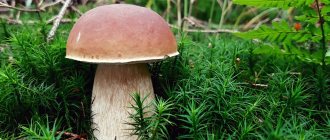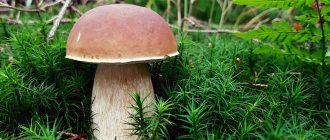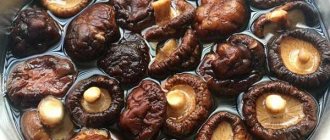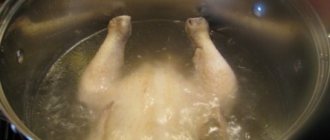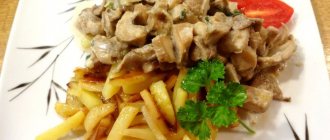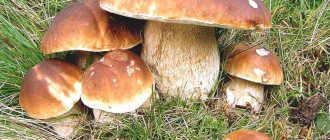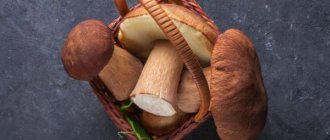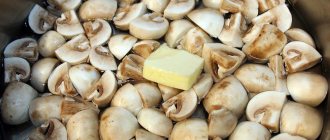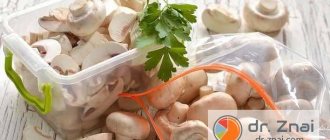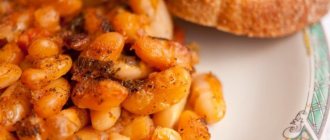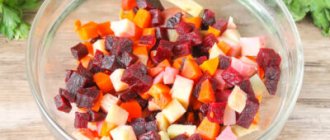Preparing mushrooms
The popularity of porcini mushrooms is due not only to their amazing aroma and taste, but also to their low calorie content.
Moreover, these properties are retained even after prolonged heat treatment. Properly processed mushrooms are the main thing in the preparation of soups and winter preservation. Therefore, this procedure requires care and attention. For those who are not familiar with this procedure, we will tell you what manipulations should be performed. Cleaning the mushroom begins with removing dirt and pine needles, which should be done directly in the forest (if you collected the mushrooms yourself). On the spot, you can also cut off a third of the stem and inspect the cap, checking the product for damage by worms (if any are found, the mushroom should be discarded). The product must be washed before preparing the soup. In cases where you plan to dry the mushrooms, then this step can be skipped. Wash porcini mushrooms exclusively with cold water, without soaking. However, when it is not possible to start cooking immediately after collection, they can be soaked in cool water, to which a spoonful of citric acid is first added. This will allow you to delay their cooking for about eight to ten hours. For cleaning, many people use brushes with medium soft bristles, for example, toothbrushes.
When cleaning the surface of the mushroom with it, you need to pay close attention to its cap, and especially its lower part, where the tubular layer is located. If dark spots or pinpoint lesions are found, they must be cut off with a sharp knife. When washing, it is better to cut the mushroom cap in half
This will ensure better removal of fine dirt. Further drying should be done on a wire rack, otherwise the mushroom will retain some of the water, no matter how long it sits.
After collecting the mushrooms, it is advisable to clean them on the same day, remove dark places, and cut off parts affected by slugs and worms. For old mushrooms, trim off the bottom of the cap.
If cooking mushrooms is postponed, they must be placed in the refrigerator for safekeeping. This product is not washed, but only carefully cleaned off with a knife the adhering particles of sand, leaves, blades of grass and other small specks.
Just before cooking, the mushrooms are rinsed in cool water, but this should be done quickly so that they do not have time to absorb a lot of moisture.
Mushroom stems are subject to processing. Their edge is completely cut off. As a rule, the edge is shrouded in dirt, which is almost impossible to remove efficiently. Often there are dots and dark inclusions. They may indicate the presence of worms. Therefore, it is also better to get rid of dots. To get rid of worms, mushrooms are filled with saline solution for 20-30 minutes.
Next you need to separate the caps and legs. Only now the product is thoroughly washed under running water. It is better to wait until the mushrooms dry before cooking or frying. Large units need to be cut, medium ones should be cut into two parts. If the mushrooms are small, they can be cooked whole.
General issues
7 dangerous properties of milk: a must-read for everyone so you don’t regret it later!
Recommendations for processing
The basic rules for processing mushrooms are almost the same. But some differences still exist, it depends on the type:
- Butter: do not wash them before cleaning, otherwise they become slippery. It is worth removing the film from the cap. The fruiting bodies are soaked in salt water for half an hour.
- Honey mushrooms: they are cleaned in slightly warm water if drying is not planned. Remove dirt with a toothbrush or rag.
- Saffron milk caps: the fruiting bodies are wiped with a rag, washed under running water, and the stem is trimmed.
- Porcini mushrooms: clean with a knife. Before drying, gently wipe with a towel. Cooking involves soaking for 15 minutes, after which the fruiting bodies are washed with a non-hard sponge.
- Forest oyster mushrooms: they are undemanding to clean. The dark spots are removed, uneven edges are cut out, and the legs are cut off.
- Champignons: wipe them with a damp sponge and trim the stem (refresh the cut).
- Boletus mushrooms: the scales covering the stem are removed.
- Milk mushrooms: all collected specimens are soaked for a day, constantly changing the water. After this, wash thoroughly with a sponge (for black milk mushrooms, you can use a knife).
- Chanterelles: carefully remove dirt from records. Hats are wiped with a damp cloth. Soak for 10 minutes.
How long should you cook?
The cooking time for boletus mushrooms may depend on what dishes they will subsequently be used for.
For soup
Small unchopped mushrooms look impressive in mushroom soup.
To make the taste more intense, experienced chefs recommend boiling mushrooms directly in the soup, adding them about an hour before cooking. The broth acquires a unique aroma, but this method is only suitable for boletus mushrooms collected in ecologically clean areas.
Otherwise, before adding mushrooms to the soup, pre-boil them for half an hour after boiling.
Before frying
Obabki fried with onions and seasoned with sour cream, or with sliced potatoes are incredibly tasty and aromatic.
You can fry them directly raw, bringing them to readiness for about an hour. But it’s better and safer to put already boiled boletus mushrooms in the frying pan. To do this, they need to be peeled, coarsely chopped and cooked after boiling for 30–45 minutes, depending on the size of the mushrooms: the larger, the longer.
Before freezing
Many people freeze mushrooms raw and in their whole form. But it is much more convenient to store boiled fruiting bodies: they take up less space in the freezer, and after defrosting they are a finished product.
To understand how long to cook obabki for freezing, you need to decide whether you will chop them or whether you need them whole. Large mushrooms are boiled for 40–50 minutes, small ones and cut into pieces are enough to boil for 30 minutes after the water boils. You can add spices and a small amount of salt to the water.
Other options
Dried boletus mushrooms can also be boiled. Before subjecting the mushrooms to heat treatment, they are soaked for a couple of hours in cold water. Afterwards you need to cook the boletus mushrooms for 2 hours in the same water in which they were soaked.
https://youtube.com/watch?v=P1i57qEY0wU%3F
How to dry mushrooms?
To dry the product, you need to know how to process fresh mushrooms. A product that is not properly prepared for storage will quickly deteriorate. For drying, tubular types (white, boletus, boletus) or lamellar (russula, honey mushrooms or chanterelles) are most suitable.
It is better to dry strong, not old mushrooms without damage. They should never be soaked or washed. To remove dirt and debris, use a damp cloth. Mushrooms are dried separately for each type, if necessary, cut into pieces. Hats can also be divided into parts. In order for the mushrooms to dry faster, their thickness should be 3-5 mm. Cut conveniently with a sharp knife, placing the spongy side up.
Features of the species
Fragrant and appetizing boletus and aspen mushrooms have always been an integral food product in Russia. Despite the fact that both types are similar to each other, they still have significant differences.
boletus
Walking through a birch grove, especially in places where the sun warms the ground well, you can often find a boletus mushroom - tall, slender, on a long leg and wearing a beautiful convex hat, which over time becomes like a pillow. Its diameter can reach 15 cm. In its appearance, the boletus mushroom resembles a porcini mushroom, but unlike it, the boletus leg is covered with small gray or black scales.
The color of the fruit varies depending on the place of growth and can be from light beige to black and brown. There are several types of boletus: Common, Swamp (or White), Black, Pinkish, Tundra, Hard, Gray and Multi-colored.
You may be interested in:
What the boletus mushroom looks like and its description (24 photos) The bright dense cap, reminiscent in color of autumn foliage, the thick stem, impressive size and pleasant taste made...Read more...
The most common boletus is the common boletus. It is recognized by its uniform color and stem, which thickens at the bottom. They love it not only for its taste. Boletus cleanses the body of toxins, has a positive effect on the nervous state, regulates blood sugar, helps with kidney problems, has a beneficial effect on the skin and is not high in calories (only 20 kcal per 100 g) and is rich in various microelements necessary for the body.
Boletus
In mixed forests and aspen groves you can find mushrooms with bright red caps and a stocky stalk covered with scales. These are boletuses. They received this name because of their color, which is very reminiscent of the autumn foliage of aspen.
But contrary to popular belief that these mushrooms grow only near aspen trees, they can be seen under oaks, lindens, poplars, willows and other trees. They also love to live in a humid environment among moss, blueberry bushes, grass and ferns.
There are several types of boletuses. The most famous are: Red, Painted Legs, White and Oak. Boletuses are very valuable for their healing properties. It is believed that they cleanse the blood, help reduce cholesterol, remove heavy metal salts, poisons and radionuclides, have an antitumor effect, help normalize the intestinal microflora, and increase immunity.
Preparation
To make the task of initially cleaning porcini mushrooms easier, you need to soak them in water for a short time. To do this, carefully transfer the boletus mushrooms into an enamel pan. Fill completely with cold water, add a small amount of salt (this will get rid of insect larvae).
Place pressure on top so that the mushrooms do not float on the surface. After 10-20 minutes, the water must be drained, otherwise the boletus mushrooms will absorb moisture, and this will not have the best effect on their taste.
Important! The calorie content of porcini mushroom in its raw form is only 22 kcal per 100 g. But after drying, it soars to 286 units. So people who are prone to obesity need to choose other methods of preparing boletus mushrooms, for example, making fried, boiled or pickled mushrooms.
How long should you cook blueleg mushrooms before frying?
Porcini mushrooms in our country grow in coniferous and deciduous forests. Experienced mushroom pickers know how to properly collect, process, store and, of course, cook them. But cooks who are far from this matter are interested in how long to cook fresh porcini mushrooms before frying. Their heat treatment lasts for 35-40 minutes. This time is enough for the product to reach readiness.
But there are also some peculiarities. Most professional chefs believe that mushrooms can be half cooked before frying. So how long should you cook porcini mushrooms before frying? A third of an hour is enough. But provided that you further fry them and simmer for at least 15-20 minutes.
Dried mushrooms are often found on store shelves, especially in big cities. They taste the same as fresh ones. And their aroma is simply divine! Before heat treatment, dried porcini mushroom must be soaked. This procedure takes approximately 3-4 hours.
Before heat treatment, the mushrooms need to be properly prepared. Fresh white mushrooms are cleaned, carefully removing dark spots. They are then washed under running water. If there is a lot of dirt and leaves on the surface of the legs and caps, it is better to soak them first. This will make your cleaning task easier.
Mushrooms are usually fried in odorless, refined vegetable oil. If you want to improve the taste of the treat, add melted butter in equal proportions to the vegetable oil.
Greens, cheese, onions and carrots are faithful allies of fried mushrooms. The dish turns out to be incredibly tasty if you top it with sour cream sauce. And not only this fermented milk product is used to prepare porcini mushrooms. Try pouring cream with a medium fat content over the mushrooms.
Porcini mushrooms are not only boiled on the stove. Many housewives resort to using a multicooker. Select the “Baking” program mode and set the timer to 40 minutes
It is worth paying attention that the kitchen appliance will take time to heat the water. To save time, you can pour already hot water into the multi-cooker container
We recommend pouring cold water over the mushrooms and boiling over low heat for 3-5 minutes. Next, drain the water, fill it again with cold water and repeat the procedure. If you are completely confident in your mushrooms, cook the mushrooms in one water for 10 minutes.
Before cooking, chop the mushrooms, since after cooking it will not be possible to do this carefully.
Freezing mushrooms has become more rational than rolling them. No, pickled and salted mushrooms have been and will be desirable, but for winter frying, soups and purees, it won’t hurt to prepare delicious mushrooms.
We clean and cut as we will cook it later. I recommend thinking ahead and cutting it this way:
- In four parts
- In slices, set the stems aside separately and chop only the caps
- Chop into cubes for soup (the legs will go here)
- If you plan to stuff the caps in winter, separate them from the stems, gently boil them, cool them, place them on a leaf and put them in the freezer. After freezing, you can add them together, but make sure that each cap is frozen separately.
Porcini mushrooms are the kings of the mushroom world. At least on our tables. Clean, wash and pour boiling water, be sure to add a spoonful of salt to the pan.
After boiling, cook for 30-40 minutes over low heat, constantly skimming off the white foam.
Fried potatoes with butter - delicious. The question often arises of how to cook them deliciously, because there are a lot of difficulties with them.
We clean the cap, removing the top layer, and also clean the legs from dirt. Wash, add hot water and cook for 10 minutes. Wash, dry and place in a frying pan, preferably with onions.
Boiling mushrooms before frying has two purposes: to remove toxins, if any, and to soften the structure of the mushroom. Bluelegs are excellent fried without cooking, but skeptics can cook for 10 minutes to get rid of toxins and doubts about their existence in bluelegs.
Wild mushrooms are boiled before further preparation according to the following scheme:
- Peel the mushrooms from the bottom of the cap.
- Rinse thoroughly to remove soil and other dirt.
- Fill an enamel or metal pan with water so that the mushrooms float freely in it.
- After boiling, cook the product for 20-60 minutes, depending on the type. The contents should not stick to the walls or bottom.
- If desired, add salt and spices at the end of cooking. Although most often this is done during the next processing.
Harvesting mushrooms
Mushrooms
- wonderful and tasty gifts of the forest - will be even tastier if they are properly prepared. First of all, this is necessary so that various microorganisms, larvae and other invisible parasites cannot live and develop in mushrooms. Of course, some mushrooms can be eaten raw, but in the vast majority of cases heat treatment is necessary. There are several ways to prepare mushrooms, each of which can be part of a process or a recipe in its own right.
What should you do with mushrooms first? First, the mushrooms must be sorted by type and size, cleaned of debris, adhering leaves, dirt and pine needles. Then you should check the mushrooms for damage. Bruises, brown spots and parts eaten away by worms and slugs should be removed. In some cases, it is necessary to remove the damaged cap (from russula, boletus and others), since it most often contains the main amount of harmful alkaloids. For old and overripe mushrooms, cut off the bottom of the cap, the so-called spore-bearing part. Rough old legs are also cut off. It is better to process mushrooms on the day of collection. This is important for preserving all the beneficial qualities of forest gifts. If for some reason it is not possible to process them on the same day, they can be left until the morning. In this case, the mushrooms should be cleaned of dirt and leaves, but not washed! It's a good idea to place the mushrooms in the refrigerator or a cool, dark place. Mushrooms intended for cooking can be filled with cold water.
Harvesting mushrooms: washing and soaking mushrooms
. This method often precedes any cooking of mushrooms. Forest gifts must always be thoroughly cleaned of debris, dust and dirt in order to continue preparing healthy dishes from them. The exception is mushrooms intended for drying - they cannot be washed or wet at all, but only carefully remove all debris and wipe with a damp cloth. Mushrooms should not be washed for a very long time, otherwise they can absorb a lot of water, which later complicates the cooking process. Usually rinse under running water for several minutes and allow the water to drain. Porcini mushrooms are scalded with boiling water 2-3 times to give elasticity and reduce fragility when cutting. Dried mushrooms are soaked for 2-4 hours, after which they are boiled in the same water for 40-60 minutes. Sometimes pickled mushrooms are soaked if they are going to be added to soup or fried.
Preparing mushrooms: cooking mushrooms
– the most common method of cooking mushrooms. It allows you to reduce the content of dangerous poisonous alkaloids in mushrooms, such as gilvelic acid, contained in some mushrooms, especially morels and strings. When cooking, the acid goes into water, so these mushrooms are boiled twice, be sure to pour out the water after cooking, and the mushrooms are washed in hot water. It is necessary to boil yellow and black milk mushrooms, brittle russulas, and pink frills. Cooking reduces radioactive contamination if you are unsure of the mushrooms collected or the collection area. Thus, one-time cooking for 10 minutes reduces radiocesium radiation by 81%, and two-time cooking by 97%. Soaking also has a good effect on reducing radioactivity. It is important to remember that cooking also reduces the content of useful substances, such as vitamins, in mushrooms. In order to minimize the loss of vitamins, little water is needed for cooking. The more water is used in relation to mushrooms, the less vitamins will remain in the finished dish.
Roasting mushrooms
. You can fry almost any mushroom. Some types require mandatory pre-cooking, at least for 10-20 minutes. Perhaps only white mushrooms, champignons and chanterelles can be fried without any preparation. Large mushrooms are cut into equal, not too large (but not very small) pieces and thrown into a frying pan with thick walls, preferably cast iron. A lot of moisture comes out of the mushrooms; they literally swim in the juice, which evaporates and bubbles abundantly. This is fine. When the juice becomes critically low, you can add oil, onions and spices and, after frying until done over a moderate flame, remove the mushrooms from the heat and let them simmer in a hot frying pan. It is important to prevent the mushrooms from sticking to the bottom of the pan. You can use non-stick cookware for this, but mushrooms taste better in a heavy cast-iron frying pan.
Blanching mushrooms
. With this processing method, mushrooms are scalded with boiling water or immersed in boiling water for some time (usually several minutes). Sometimes boiling water is replaced with steam. In this case, the mushrooms are kept over steam in a sieve. Russulas and saffron milk caps are usually blanched. The general procedure is as follows. The amount of water should be 4 times the volume of mushrooms. Dip small whole or large mushrooms cut into pieces in boiling water for 2-3 minutes, then place in cold water for 5-10 minutes, or even better - under a running stream of ice water for quick cooling. The same steps apply when using steam. Blanching destroys most unwanted microorganisms and is especially suitable for mushrooms that are planned to be frozen. Some types of mushrooms can be preserved after blanching, for example porcini mushrooms.
Stew mushrooms
Can be done either alone or with other vegetables, such as potatoes. This is one of the most delicious ways to cook mushrooms. Mushrooms are stewed with potatoes, sour cream or butter, this makes them slightly steamed and fried, permeating the entire dish with their aroma. You can bake mushrooms in the oven, just like vegetable dishes. The requirements and conditions are approximately the same.
Procuring mushrooms for future use by practical housewives allows you to enjoy mushroom dishes all year round. There are several main ways to preserve mushrooms: salting, pickling and freezing.
, each adding its own flavor profile. One very important detail - you cannot add onions to mushrooms if they are intended for preservation. Such mushrooms will definitely spoil. Onions should be added during the actual preparation of the mushroom dish.
Pickling mushrooms
. Lamellar mushrooms are especially well suited for this method - russula, volushki, saffron milk caps, milk mushrooms, honey mushrooms, chanterelles and others. There are two methods of salting - cold and hot. Cold means that selected and sorted mushrooms are soaked in cold water for 2-3 days. The water is changed periodically, as mushroom milky juice is released into it. All cold salting operations are best carried out in a cool room - in the basement or cellar. This is necessary to prevent the mushrooms from fermenting. The soaked mushrooms are placed in an enamel bowl or barrel to the brim, sprinkled with salt (3-4% salt, or 300-400 g of salt per 10 kg of mushrooms), seasonings and spices are added.
You can dwell in detail on this important element of salting. It is the spicy herbs that form the necessary fragrant aroma, which, when combined with the mushroom one, creates that alluring bouquet that so awakens the appetite. Currant leaves, bay leaves, garlic, dill, pepper and sometimes basil are placed at the bottom of a barrel or large enamel pan, then a layer of mushrooms, then again a layer of spices and so on, not forgetting to sprinkle with salt. (Saffron milk caps do not require spices; they should be added very carefully.) A heavy wooden circle with holes is placed on top of all layers or, as a last resort, a lid of smaller diameter than the container, sometimes a weight is added on top. This is called salting “under oppression.” Gradually, as the mushrooms settle in the pickling container, you can add a few more layers and place the mushrooms in a dark, cool place. The saffron milk caps will be ready in 10-12 days, and the milk mushrooms in 30-40 days. The hot salting method requires preliminary blanching. The scalded mushrooms are then placed on a sieve or sieve, the water is allowed to drain and placed in a bowl with spices and salt. Then proceed according to the same scheme as with the cold method.
Marinating mushrooms
. Usually they marinate mushrooms, which when fresh (boiled, fried and stewed) are not as tasty as their counterparts growing at the same time. For example, porcini mushrooms are usually eaten fresh, although they can also be salted and pickled, but this is considered impractical in relation to delicious porcini mushrooms. Although, if the harvest of porcini mushrooms is especially large and all the mushrooms are simply physically impossible to eat fresh, they are, of course, stored for future use. The most commonly pickled vegetables are boletus, honey mushrooms, saffron milk caps, chanterelles, aspen boletuses and boletus mushrooms. Different types of mushrooms should be marinated separately. You cannot mix different mushrooms in one container, otherwise they will either darken and become uniformly brown and ugly, or will cook unevenly. Moreover, to preserve the taste, it is good to cook the stems and caps of even one type of mushroom separately. You need to remove the skin from the cap of the buttermilk. Here is one of the many pickling options. Pour the mushrooms into a pan (non-oxidizing, preferably enameled), after cleaning, rinsing, dividing into types and stems. Pour water, add salt, spices and citric acid. Next, cook the mushrooms until they settle to the bottom and the broth becomes transparent. Skim the foam periodically and be vigilant - mushrooms require attention. At the very end of cooking, add vinegar mixed with mushroom broth. Then pour the mushrooms along with the broth into prepared (sterilized) jars, close the lids, sterilize the jars in boiling water: liter jars for half an hour, half-liter jars for five minutes less. After sterilization, quickly roll up the jars with lids and leave to cool.
Drying mushrooms
. Very good and simple method. Suitable for almost everyone, as it does not require complex operations and special equipment, or this equipment can be made at home. If not all, then many mushrooms can be dried. Usually dried are white mushrooms, honey mushrooms, boletus, boletus, boletus, champignons and chanterelles. You can dry mushrooms in the sun, in ovens, ovens and other heating devices. Dry outdoors in dry and sunny weather. In high humidity or without sun, mushrooms can become moldy. Whole, undamaged specimens not eaten by worms and caterpillars are selected for drying. The mushrooms are cleaned of debris (leaves, lumps of dirt, pine needles, etc.) and wiped with a damp cloth (but not washed - the mushrooms will absorb water and dry very slowly, which can ruin them). It is best to dry on wooden racks or meshes.
There are many methods of drying in a Russian oven, but since ovens are now a museum rarity, we will not list them. Each house has a stove with oven. The general principles of oven drying can also be applied to oven drying. It is important to remember that in the oven the heat comes from all sides and dries evenly, but in the oven the heat comes from below and therefore the mushrooms need to be turned over to dry evenly. The ideal temperature for drying is within 60-70 degrees, but no more, otherwise the mushrooms can be overdried, they will become brittle and lose their beneficial properties and taste. Mushrooms release a lot of moisture, so it is advisable to keep the oven door slightly open. The degree of readiness of the mushrooms is determined by bending test. Mushrooms should be light, dry, bend slightly, and break if pressed. If the mushrooms break even with little effort, it means they are overdried.
Freezing mushrooms
is now one of the most accessible methods of harvesting mushrooms for future use. For freezing, you should select strong, small-sized mushrooms collected in a dry forest. White boletus, boletus, boletus and champignon mushrooms are well suited for this. The freezer temperature should be -18 degrees or lower (usually three degrees in household refrigerators). The best result is achieved by pre-blanching. Prepared mushrooms are placed in plastic bags and placed in the freezer. It is better to freeze those types of mushrooms that do not require long cooking. You can freeze boiled or fried mushrooms, divided into portions per cooking – for convenience. You should prepare dishes from frozen mushrooms only after they have been completely defrosted. Very small mushrooms can be placed in small baby food jars - such a jar is enough for one quickly prepared serving. Frozen mushrooms can be stored for quite a long time - up to two years, but they are usually stored until next summer.
Mushroom powder
. Mushroom powder is good because it is easy to use in cooking, adding it to all kinds of dishes: gravies, sauces, soups, or to add a mushroom flavor when stewing vegetables. In addition, crushed mushrooms are better absorbed by the body. It is best to prepare mushroom powder from porcini, saffron milk caps, chanterelles, boletus and aspen mushrooms, or from a mixture of different mushrooms. To prepare the powder, the mushrooms are first thoroughly dried and then ground in a coffee grinder, pepper mill, or mortar in a porcelain cup. If the powder turns out to be heterogeneous, large particles can be sifted out through a fine flour sieve and ground additionally. Before cooking with mushroom powder, it must be soaked for 20-30 minutes to swell and then added to the dish 10-15 minutes before cooking.
Olga Borodina
How to cook porcini mushrooms
How to cook fresh porcini mushrooms?
- Clean the mushrooms from debris and dirt, cut off the wormy parts and the end of the stem.
- Rinse thoroughly under running water.
- Place in a container with water and leave for an hour to completely remove dirt from the outer and inner surfaces.
- Then peel each mushroom and cut into pieces.
- Place peeled and washed mushrooms in a saucepan, add water, covering the top by 2 cm. Add salt at the rate of 1 tsp. for 1 liter of water and put on fire.
- After boiling, skim off any foam that has formed and continuously remove it during the cooking process.
- Within 40 minutes the porcini mushrooms are ready. To give them aroma and enhance the taste, it is recommended to add spices and boil for another 15-20 minutes.
How to cook porcini mushrooms for freezing?
To freeze a portion of porcini mushrooms for further heat treatment, they are first boiled. The process is similar to cooking fresh mushrooms, only they should be cooked for no more than 20 minutes.
How to cook porcini mushrooms before frying?
Before frying, cook according to points 1-6 of the above process for preparing fresh mushrooms with a time difference. The mushrooms must be boiled for 20 minutes, followed by heat treatment until fully cooked.
How to cook frozen porcini mushrooms?
Before preparing a dish of frozen porcini mushrooms, they should be thawed at room temperature. Then the mushrooms are washed and boiled in salted water for 15-20 minutes until fully cooked.
How to cook dried porcini mushrooms?
Dried mushrooms must be pre-soaked. To do this, pour a portion of mushrooms with clean cold water and leave for at least 1 hour (ideally 2-3 hours, and for old mushrooms - at least 8 hours). After washing, the mushrooms are ready for further heat treatment. They need to be cooked for 30-40 minutes.
How to cook porcini mushroom soup?
We recommend preparing the ideal option - creamy porcini mushroom soup with cream for 6 servings.
Ingredients:
- porcini mushrooms – 600 g;
- champignons – 6 pcs. (+2-3 things for decoration);
- chicken broth – 800 ml;
- onion – 1 pc.
- garlic – ½ large clove;
- butter - for frying;
- flour - 3 tbsp. l.;
- cream 20% - 200 g;
- salt, pepper and spices - to taste.
- Porcini mushrooms can be used fresh, frozen or dried. After the preparatory stage (fresh for soup, frozen or pre-soaked dried mushrooms are boiled for 15-20 minutes), the resulting infusion is not poured out. Porcini mushrooms, along with diced onions and champignons, are sent to a frying pan greased with butter and fried for 5-7 minutes.
- Part of the previously obtained infusion of boiled mushrooms is fried in a frying pan with flour, stirring constantly until a sauce-like consistency is formed. The finished sauce should be strained to get rid of any lumps of flour.
- The frying, sauce and remaining mushroom infusion are sent to a pan with the addition of chicken broth and spices (garlic, salt, pepper and spices to taste). The soup is cooked for 15 minutes and at the end of the process, remove the garlic.
- Cream is carefully poured into the finished mixture, stirring thoroughly. Then everything must be blended with a blender until a puree-like mass is formed and put on the fire, stirring constantly, and without bringing to a boil, remove from the stove. The finished dish can be decorated with pre-fried thin slices of champignons and herbs.
Proper drying of mushrooms
The best way to prepare dry mushrooms is to place them on the bottom shelf of the refrigerator for 2 weeks, with sheets of thick paper underneath. After the specified time has passed, the mushrooms need to be taken out, allowed to dry at room temperature, and then put into special cloth bags and stored.
Dishes with dried mushrooms will turn out tastier if you soak the mushrooms in warm milk and add a sprig of rosemary. The mushrooms will acquire a unique taste and aroma.
Cooking mushrooms is very easy
You need to put it in a saucepan, add a small amount of water, add salt and, after boiling, keep it in boiling water from five minutes to one hour, depending on the type. If mushrooms are processed for further frying, they need to be cooked for 10 - 20 minutes less than indicated in the basic recommendation. Then remove from the water, chop or grind in a meat grinder and use according to the main recipe.
A very tasty winter preparation will be made from boiled fresh mushrooms prepared according to the following recipe.
Ingredients :
- two kilograms of fresh mushrooms;
- one and a half liters of water;
- a spoonful of salt (the amount of salt can be varied to suit your taste);
- two black currant leaves;
- head of garlic;
- ten black peppercorns.
Preparation
- First, you need to sort the mushrooms, clean off the forest dirt, and rinse them in small portions in a colander.
- In a large bowl or saucepan, soak the entire amount of mushroom “meat” and add a portion of fresh cold water.
- Place a small pressure in the form of a plate of suitable diameter so that all the mushrooms are under water.
- After an hour and a half, rinse the soaked mushrooms again, chop the large ones, and leave the small ones whole.
- Pour one and a half liters of water over the mushrooms and bring to a boil over high heat.
- As soon as the water boils, reduce the heat, add pepper and salt, currant leaves and garlic.
- Cook for 20 minutes, then remove the mushrooms with a slotted spoon and cool.
For winter freezing, place the cooled mushrooms in bags in small portions of about half a kilogram (exactly as much as you need for mushroom soup, frying with potatoes, making a pie, etc.) and place in the freezer. It is important that there is as little air as possible left in the bag of mushrooms.
https://www.youtube.com/watch?v=channelUCepCBVe_flppg7YKvG7VVmQ
Mushrooms frozen this way can be stored for one year.
Preparation for the winter
During the harvesting process, mushrooms undergo two cooking processes: pre-treatment over fire and in marinade.
It is important to consider that with prolonged cooking, mushrooms lose their taste and fall apart.
Experienced housewives answer the question of how long to cook porcini mushrooms until tender:
- Initially, they are kept in boiling water for 15 minutes from the moment the water boils.
- All foam from the surface must be removed. Already in the marinade they are boiled for another 15 minutes.
- The total time is enough to produce a high-quality product.
The broth can be frozen and used as a semi-finished product when preparing sauces, gravies or soups. This is done in several steps:
- Cooking time depends on the condition of the mushroom (from 20 to 40 minutes).
- Place a plastic bag in a clean mayonnaise bucket.
- The broth is poured in. You need to leave a small margin to the edge, since the liquid expands as it freezes.
- The bucket goes into the freezer.
- The frozen liquid is removed from the mold and stored in a bag until required.
For freezing, prepare a concentrated broth at the rate of 200 g of mushrooms per 500 ml of water.
Taste qualities of the product
Most likely, everyone has heard about the significant nutritional, and in some cases even medicinal properties of this mushroom. But at the same time, they have earned genuine love and fame precisely because of their excellent culinary properties. The spectacular aroma and recognizable taste of such mushrooms make them an excellent product for preparing certain dishes or as an additive as an ingredient in dishes with a richer composition of ingredients. Whatever is prepared from these popular gifts of the forest! From them and with their participation they make:
- pickles;
- stewing;
- frying;
- marinades.
They are also baked, dried, ground into powder, etc. The mushroom is equally good in a variety of forms. And its incomparable aroma, like no other, perfectly emphasizes the taste properties of fried chicken, baked beef, buckwheat or stewed pork. During poor harvests or in winter, well-marinated or salted strong porcini mushrooms will become a dear guest at any feast in honor of any celebration.
How to process conditionally edible mushrooms after collection
How to distinguish conditionally edible mushrooms
Is there a difference between poisonous and inedible mushrooms? Isn't this the same thing? No. The fact is that inedible mushrooms are not eaten in most cases, not because they can cause great harm to the body, but because:
- unpleasant taste or smell;
- small fruiting bodies;
- pulp hardness;
- growths on the fruiting body (scales, thorns, etc.);
- specificity of the place of growth;
- rarities.
In addition to the listed parameters, the inedibility of mushrooms can also be expressed in the content of a certain amount of hazardous substances. Eating such mushrooms will not lead to death, but it can cause poisoning. Poisonous mushrooms should never be consumed, under any circumstances! Even during the process of cooking and drying, hazardous substances do not evaporate from them, and poisoning with them can lead to death. The most poisonous mushroom currently is the toadstool.
There are different ways to prepare mushrooms. They are boiled, fried, stewed, dried, baked, canned, and sauces are made from them. Whatever you are going to do with them, do not forget about the pre-processing of the mushrooms - sorting, clearing debris, washing, which we talked about above.
Rules for collecting conditionally edible mushrooms
- never collect old, wormy, diseased mushrooms;
- never take mushrooms that have grown on the edge of or near a highway, railroad, factory, etc. The fact is that these gifts of nature, like sponges, absorb all harmful substances from the environment, so in some places even edible mushrooms, “fed » toxins and other hazardous substances that may become toxic;
- never pick suspicious mushrooms. If there is even the slightest doubt about the edibility of a mushroom, it is better to throw it away;
- Do not store mushrooms for a long time! The sooner you use them as intended, the less likely they are to spoil and cause harm to your body.
Features of processing conditionally edible mushrooms after collection
You should not deny yourself the pleasure of eating mushrooms, which are included in the column entitled “Conditionally edible”. This name literally means: “edible, but subject to certain conditions.” Usually this is a special preparatory treatment, i.e., before preparing a certain dish from mushrooms, they should be boiled, soaked or dried. These methods are presented in strict sequence: as the time for pre-processing the mushrooms increases.
Delicious recipe! Juicy pink salmon in the oven with cream
If you correctly understand how to process mushrooms after picking and use our tips to distinguish conditionally edible mushrooms, you can not only prepare mushrooms for the winter, but also benefit from mushroom dishes.
How to cook fresh honey mushrooms before frying and for pickling for the winter
If you know exactly how to cook fresh honey mushrooms for frying, then you can be 100% sure that the harmful substances contained in the mushrooms will be destroyed. Carefully read the recipe below, which will help you choose the right time for boiling and create a delicious masterpiece of mushrooms. Knowing how to cook fresh honey mushrooms before frying, you don’t have to worry about the well-being of your family and friends.
For the pickling process, honey mushrooms must also be boiled, as in all other cases. How should you cook fresh honey mushrooms for pickling so that the snack turns out tasty and harmless for your family? To begin with, the fruiting bodies are cleaned of contamination and only then boiled. This process lasts 15-20 minutes without adding salt. Then the water is drained, the mushrooms are placed in a colander and allowed to drain. Then make a marinade from salt, sugar, vinegar, spices and cook the honey mushrooms in the marinade for 15 to 30 minutes, depending on the size of the fruiting bodies.
At the end of summer, on tree trunks and stumps, you can find small piles of mushrooms with a yellow-orange cap. These mushrooms are called honey mushrooms, and they can be used for drying, pickling and cooking. You can read below about how to cook honey mushrooms. So.
Step 1.
After collecting mushrooms, prepare them for cooking. To do this, sort out the honey mushrooms, clean them of various debris and rinse thoroughly under running water.
Step 2.
Place the mushrooms in a small saucepan, add the required amount of water and place on the stove.
Step 3.
After boiling, hold for a couple of minutes and drain the water. Pour clean water into the pan, add salt to taste and cook for another 40 minutes. Remove the finished mushrooms to a plate and serve with sour cream. Bon appetit.
Honey mushrooms are mushrooms that are very easy to collect. They grow in large groups, and the basket of mushrooms fills up very quickly. Canned mushrooms keep well. And in winter it’s just a delicacy. They can be placed on any winter holiday table, or you can simply serve them with boiled potatoes.
Today on the site there are two recipes for canning honey mushrooms.
Pickled honey mushrooms
You will need:
Honey mushrooms
For 1 liter of marinade:
- salt - two tablespoons,
- bay leaf - a couple of leaves,
- granulated sugar - one tablespoon,
- allspice - eight peas,
- garlic - two cloves,
- table vinegar - two tablespoons.
Preparation:
Sort the mushrooms, peel and wash in running water.
Prepare a large saucepan, pour cold water into it and place the prepared mushrooms in it. Place on fire and bring to a boil.
After this, cook over low heat until the mushrooms begin to sink to the bottom of the pan. After this, stop cooking and pour out the broth.
To prepare the marinade, pour 1 liter of water into an empty, clean saucepan, add salt, sugar, bay leaves, pepper, garlic and bring to a boil. Place the prepared honey mushrooms into the marinade, bring to a boil and cook for ten minutes. Add vinegar at the very end.
The jars are already sterilized along with the lids.
Place the honey mushrooms in clean, dry jars, pour in the marinade and close with screw caps. Cool.
Then they can be stored in the refrigerator.
Canned honey mushrooms “Special”
You will need:
- Honey mushrooms - five kilograms,
- dill - two umbrellas,
- currant leaves - five pieces,
- cherry leaves - five pieces,
- bay leaf - five pieces,
- allspice - 10 peas,
- garlic - to taste,
- vegetable oil - two glasses,
- vinegar essence - one tablespoon.
Preparation:
Peel the mushrooms and wash in running water. Prepare a large saucepan, place honey mushrooms in it, add cold water and salt to taste. Bring to a boil and cook for twenty minutes.
Leave two glasses of broth and pour out the rest of the broth.
Add dill, leaves, peppercorns, garlic, previously chopped with a knife, vegetable oil, and the reserved mushroom broth to the mushrooms.
Bring to a boil and cook for twenty minutes. At the very end of cooking, add vinegar.
Half-liter jars and lids are already sterilized. Place the canned honey mushrooms into jars and sterilize them for twenty minutes. Close with screw caps.
Before using forest products in a dish, it is necessary to pre-heat them. This should be done to improve the taste, remove toxins and harmful substances that can accumulate in boletus, aspen mushrooms, milk mushrooms and other species. Find out how to cook mushrooms correctly and for how long.
Mechanical restoration
First, the harvested crop is carefully inspected. If there are unfamiliar specimens that raise doubts, it is better to throw them away. Fruiting bodies are not consumed if they:
Sorting
Mechanical processing is carried out regardless of whether the mushrooms will be used immediately, fresh or intended for canning. They are sorted by type and size because they are prepared differently and also differ in taste. Only small fruiting bodies are suitable for harvesting. Mushrooms are divided into those that are fried immediately and those that require preliminary boiling.
Cleaning
It is worth getting rid of debris and small insects brought from the forest along with the harvest. To do this, use a soft brush or rag. You can process the fruiting bodies with a knife. If the product is dried, fried, baked, it is not washed.
Irina Selyutina (Biologist):
To easily remove the film from the caps of boletus and russula, you can hold them in boiling water for 1-2 minutes, then discard them in a colander and rinse with cold water. You can simply grab it along the edge with a knife and remove it by moving your hand from the edges of the cap to the center. Clean until the surface turns white.
Then we separate the stem and make sure that there are no fungal worm passages in it or in the cap. If the lesion is large, throw away the mushroom. If the lesion looks small, cut the stem and cap into separate pieces and look again. We leave only “clean” pieces. We do not remove the skin from the cap of boletus, boletus and moss mushrooms, but immediately clean the fruiting body from forest debris and again check for worms and cut into pieces. The legs can be placed on wheels 1-1.5 cm thick, the caps can be placed on equal-sized segments - halves, quarters.
Areas of fruiting bodies damaged by pests are carefully cut out with a knife. All darkening and damage are removed. For old tubular mushrooms, remove the inner (lower) part of the cap - the tubular hymenophore.
Washing
Mushrooms should be treated with cold water. Immediately after this, wait until the excess liquid drains from the fruiting bodies. Longer rinsing is required for species that have an uneven surface. These include morels, lines, etc. Sand sticks to the folded surface of the caps of these specimens, which needs to be washed off. If the fruiting bodies are intended for drying or frying, such manipulations are not performed.
Soaking
Conditionally edible species require enhanced taste.
This is achieved by immersing the mushrooms in salted water for several hours or a day. The liquid is periodically changed to fresh. For this, a low and wide vessel is selected; basins or bowls are best suited for these purposes. Afterwards the bitterness will go away. Dry fruit bodies are also soaked. This helps restore moisture. Experienced mushroom pickers recommend cutting the milk mushrooms into slices before soaking - this will better remove the bitterness from the fruiting bodies. By the way. It is not recommended to use aluminum or stainless steel utensils for soaking milk mushrooms, in order to avoid the occurrence of chemical reactions between the surface of the container and the released juice (even if mixed with water).
Slicing
Large specimens are divided into parts. To ensure that the dish has a good taste, the leg is cut into circles across the grain. The hats are divided into equal parts. For canning, small fruiting bodies are used entirely.
Differences in heat treatment of both types of mushrooms
Despite the similarities, boletuses and boletus mushrooms are still different, and therefore there are differences in their preparation.
https://youtube.com/watch?v=kmtnf3Grop4
How to cook boletus and aspen mushrooms correctly?
Clean boletuses, preferably freshly picked, are poured with cold water, heated, added some salt and gradually stirring, brought to a boil. During the cooking process, foam will appear that must be skimmed off. This is convenient to do with a slotted spoon.
After the broth boils, cook for another 20 minutes over low heat. Experienced mushroom pickers advise changing the water and, after boiling, simmer over low heat for another 5 minutes.
Boletus mushrooms take a little longer to cook. Most often, this process takes about 40 minutes. It is believed that during this time all toxins and toxic substances should be released.
Mushroom cooking process
People say that they also need to be boiled not in one water, but in two, and some housewives put an onion in the pan - if it turns blue, it means the mushrooms are poisonous. Under no circumstances should they be eaten. If the boletus mushrooms sink to the bottom, it means they are cooked correctly.
Cooking before frying
It is important to note that mushrooms must be boiled before frying, which is explained by the unfavorable environmental situation. However, you should not overcook them, as the beneficial properties are lost during the cooking process.
You may be interested in:
Pickle in jars with pearl barley and fresh cucumbers - a recipe for the winter When the harvest is harvested and you don’t know what to do with it, use useful recipes for winter preparations. Convenient…Read more…
To preserve the unique, incomparable taste of this delicacy, you can cook it for 10-15 minutes, but then be sure to fry it well. And to get a golden color to the dish, discard the mushrooms in a colander and allow the excess water to drain.
Fried mushrooms
Exactly how long to cook boletus mushrooms before frying depends on many factors, but on average, 10-15 minutes after boiling will be enough. After this, you need to wait until the water disappears, discarding it in a colander, and you can fry.
Cooking before freezing
Modern technologies make it possible to preserve food in a wide variety of ways. One of them is, of course, freezing. It makes it possible to enjoy fresh berries, fruits and vegetables in winter. However, unlike them, wild mushrooms are recommended to be boiled before freezing. This must be done until ready.
Cooking before freezing
There are several reasons for this:
- Firstly, you can eat them immediately after defrosting.
- The second reason is to reduce their size, which will save space in the freezer.
- And most importantly, the destruction of toxins.
Cooking before salting
Heat treatment of both boletus and boletus is necessary before salting - you cannot salt them raw. To do this, the fruits are peeled, washed and dipped in boiling brine for 15-25 minutes. But as mentioned above, it is advisable to boil them twice - the second time after changing the water for 5 minutes.
Cooking dried mushrooms
Dried fruits can also make a wonderful and very tasty dish. To do this, the mushrooms must first be soaked for several hours until they become soft.
Soaking mushrooms
Now you can start cooking. Wash the fruits thoroughly, change the water and put on fire. Cooking such mushrooms will take quite a long time - at least two hours.
Mushroom processing
The first priority after harvesting is processing the mushrooms. There is no need to delay the process, because the product quickly deteriorates. If it is not possible to process the crop immediately after arriving from the forest, you are allowed to postpone work for only a few hours. To properly prepare mushrooms for consumption, you need to learn certain rules.
- Mechanical restoration
- Sorting
- Cleaning
- Washing
- Soaking
- Slicing
- Heat treatment
- Boiling
- Boiling
- Blanching
- Recommendations for processing
- Conclusion
Useful properties of oil
Butter is an excellent low-calorie product. They contain only 19 kcal per 100 g. fresh product. And besides, they are digested rather slowly, and therefore leave a feeling of fullness in the stomach longer. For all these reasons, butternut squash is a great food for people looking to lose weight.
- Due to their high protein content, boletus serves as a good meat substitute for people following a vegetarian diet.
- Due to the substances they contain, boletus has a restorative effect on the human body, strengthens the immune system and helps resist viral and colds.
Maslyata is an excellent choice when you need to prepare a tasty and satisfying mushroom dish. There are a huge number of recipes for wonderful dishes made from these mushrooms, and anyone can replenish this piggy bank by happily experimenting in the kitchen with these tasty and affordable inhabitants of pine forests.
Possible problems and ways to solve them
When collecting fruiting bodies, even experienced mushroom pickers can get carried away and not notice how their poisonous counterparts got into the basket with noble whites.
The most common boletus twin is gall. This mushroom is very similar in appearance to the white one. You can distinguish it by its cut. Boletus never changes its color. Even after cooking and marinating.
But the gall fungus will immediately darken at the cut site. If during cleaning you see such an effect, you need to immediately throw away the poisonous double and wash your hands thoroughly with soap.
Bile mushroom
Another problem is mushrooms that are too old. As a rule, they are simply stuffed with worms and insect larvae.
This means they contain a huge amount of decomposition products. If you come across a heavily infected mushroom, it is better to throw it away without regret.
The harm caused by such a specimen is difficult to predict - from indigestion to severe allergic reactions.
With age, decomposed proteins accumulate in old mushrooms and their unique taste qualities are lost. Therefore, it is better not to be greedy and not to take too old copies at all.
Reference! Porcini mushroom not only has a wonderful taste, but also brings great benefits in the treatment of many diseases - atherosclerosis, tuberculosis, anemia. It boosts immunity and improves the functioning of the gastrointestinal tract.
How to cook porcini mushrooms for the winter
Components:
- freshly picked porcini mushrooms
- salt
- lemon acid
Before boiling porcini mushrooms for the winter, they are washed in water, cut into pieces, poured into boiling salted and slightly acidified water and boiled for about 5 minutes. The strained mushrooms are cooled in a saucepan with cold water. Then the well-dried mushrooms are laid out in one layer on foil and frozen at a temperature of -20 °C. Frozen mushrooms are placed in plastic bags in portions (about 200–300 g) for single use and the air is squeezed out of the bags. Mushrooms are stored in the freezer; before use, frozen mushrooms are not defrosted, but immediately immersed in boiling water. This method of processing mushrooms does not require re-freezing after thawing. This should be remembered, otherwise poisoning may occur. If you need to defrost the freezer, you should transfer the mushrooms to another. This method of processing mushrooms, of course, is not applicable in cases of power outages.
Cleaning mushrooms from debris
Mushrooms spoil very quickly, so you need to prepare them for storage quickly. A walk in the forest is a tiring activity; after returning home you want to lie down and relax. How to process mushrooms in the forest? To save time, it is worth starting processing immediately after they are picked. To do this, you need to clean each mushroom from debris and leaves, and if the skin on the cap is easily removed, then it can be removed. The mucous top must be cleaned and the film removed. Naturally, in the forest you need to spend more time walking, but at home you can relax a little.
